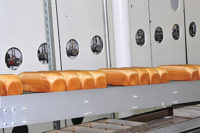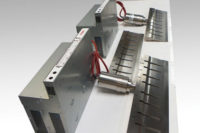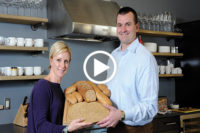The Great War
In 1914, World War I began in Europe and America entered in 1917. The war meant great hardships, and wartime in the kitchen was no picnic. Many of the everyday appliances and utensils we take for granted today didn’t exist. Many didn’t have their own cars. Food was prepared very differently. Many homes didn’t have electricity. People often made their own butter. Canning of fruit and vegetables was the only way that Americans were able to eat many foods out of season. It’s really a luxury to have many foods available on grocery shelves or produce markets year round, thanks to current advanced processing, refrigeration, transportation and preservation methods.
The government inaugurated a program of controlling the nation’s food supply. The United States Food Administration urged the nation to eat more fruit and vegetables. It also imposed a program to conserve wheat and flour. Mondays and Wednesdays were “Wheatless Days,” and bakers and the general public were asked to use mixed flours made of 75% wheat and 25% corn, rye, oats and barley. The use of such blends prompted adjustments to recipes, formulas and bread products.
Dangerous deliveries
In 1915, the Ford Model T acted as a delivery truck for some bakeries. Back then, a delivery truck only cost $720 and had a top speed of 45 miles per hour, according to information provided ASB. But during the early years of the 20th century, many bakeries relied on horse-drawn carts to deliver fresh bread daily.
One such bakery is Gonnella Baking Co., a Chicago staple for 127 years. According to Gonnella’s book published for its 125th anniversary, Gonnella Since 1886, A Family Saga of People Progress and Hard Work, those times might have seemed slower without cell phones, computers and iPads, but they were far from romantic and reasonably paced.
The book indicates that, “the hardships faced by those who delivered anything in that era can hardly be imagined by 21st-century minds.” One employee, Fabio Conti, a cousin of company founder Alessandro Gonnella’s wife, Marianna Marcucci, came to work for the bakery as a 17-year-old immigrant boy from Italy. A week after arriving in Chicago, Conti was given a job driving a horse-drawn cart. The winters were treacherous, bitterly cold, windy and icy. “The horse would fall down [on the ice], and I would have to put a blanket underneath the legs and pull him up. If I didn’t do that, he would slide down again and I couldn’t pull him up!” Conti remembers.
When Gonnella began to retire its horses and carts and replace them with delivery trucks, Conti remembers having to hand-crank the trucks to get them started. “Sometimes that took a half an hour [in the winter],” Conti says, adding that the first trucks did not have windshield wipers or heaters.
By 1916, Champion Machinery Co. of Joliet, Ill., was promoting an automatic dough-handling outfit, comprising a divider, a “rounding-up” machine, a loading device, an automatic conveyor proofer and a moulding machine. The framework for this “system” was made out of cypress wood, because it was durable enough to withstand the heat of baking better than any other wood. The equipment was able to produce 2,000 loaves an hour.
Gravity fed sifters were used by larger bakeries. Flour was dumped into a hopper and transferred through an automatic sifter and then conveyed directly to a mixer. A screened, wooden box with a brush attached to a long rod extending through the box acted as the sifter. The flour would flow from the sifter to a mixing bowl, courtesy of a canvas chute. Mechanically developed flour bins followed the development of the sifter. Almost all sifters were made of wood at the time.

















